
For many years, local historian Yuri Dmitriyev researched mass executions and Soviet crimes in the northern region of Karelia. Photo courtesy of Natalia Shkurenok. All rights reserved.
This year, as Russia marks the 100th anniversary of the October Revolution and the foundation of a regime based on terror, a courtroom in Petrozavodsk, capital of Russia’s Republic of Karelia, is the stage for the trial of Yury Dmitriyev, a local history specialist and human rights campaigner. Dmitriyev has devoted most of his life to restoring Russia’s historical memory (and with it, a chance for Russia to return to moral standards).
He is now being tried on trumped-up charges of child pornography and firearm possession. I spoke to Dmitriyev’s friends and family, as well as forensic experts, to try and find out the truth.
A daughter speaks out for her father
“Over these last months, since my dad’s arrest, I’ve begun to look at a lot of things differently,” says Ekaterina Klodt, Dmitriyev’s elder daughter. She looks tired but is happy to talk.
It’s early August and we are chatting on a makeshift wooden bench in the heart of the memorial complex at Sandarmokh, on the northern shore of Lake Onega in Karelia. Sandarmokh, a forest 12km from the town of Medvezhegorsk, is the place where, in a space of roughly 10 hectares, between 6,500 and 10,000 people were shot during the Great Terror in the 1930s. People of 58 different ethnicities, and citizens not only of the Soviet Union, were killed here. And here, by the order of NKVD chief Nikolai Yezhov, over 1,000 prisoners of the Solovetsky prison were shot and buried between 27 October and 4 November 1937.
When Ekaterina was 12, her father brought her to this forest for the first time, to look for the burial places of people shot during Stalin’s terror. Every year since, for almost 20 years, Yury Dmitriyev has held a ceremony to commemorate those who died at Sandarmokh on the same date, 5 August. This year was the first that Dmitriyev couldn’t attend; he was represented by his elder daughter and her son, Daniil. His adopted younger daughter, 12-year-old Natasha, is the subject of the supposedly indecent photo that led to his arrest and trial.
“It’s hard for all of us,” Ekaterina tells me, “but it’s hard for me, in particular, because I’m the one in the spotlight giving interviews, which I’m not used to. I’ve also changed my attitude to what my dad does. Up until now we didn’t see his work as anything out of the ordinary — it’s something we’ve been living with for many years: he digs, he restores memory, he gives people back their names. We didn’t know any other way of life. But now I look at all the people who come here — and there are more and more of them — and if before I was just proud of my father, now I realise what an extraordinary person he is. I worry about him a lot.”

Ekaterina Klodt with her son. Photo by Natalia Shkurenok.The criminal investigation against Yury Dmitriyev was opened at the end of 2016 — he was arrested at his own home on 13 December. He was initially charged with “child pornography” after investigators found photos of Natasha on his computer, in a folder called “health diary” that no one knew existed. None of the photos were to be found anywhere else, on his desk or in other folders on his computer, let alone in any public place.
If before I was just proud of my father, now I realise what and extraordinary person he is.
These photos were taken by Dmitriyev over several years — and for a purpose. Dmitriyev adopted Natasha when she was three, from a children’s home nearly eight years ago. At the time, his other children were already adults and he had a young grandson. Natasha was in poor physical condition. She had frequent illnesses, and her adoptive parents tried hard to improve her health. One day the head of the nursery that she attended made a great fuss — the child, she said, had bruises on her body from beatings. It turned out that the “bruises” were stains from newspaper pages — her mother would place newspaper between mustard plasters and her skin, to protect it (every Soviet child was probably subjected to this form of treatment) and the blue marks disappeared when a damp sponge was applied.
After that, Dmitriyev regularly measured Natasha’s height and weight and took photos of her, as proof of her health and normal physical development. As the years passed, he took fewer photos, but they all went into the “health diary” folder, from which they passed into the hands of a detective thanks, it turned out, to an anonymous denunciation. The folder held 144 photos altogether, nine of which have been since categorised as “pornographic.”
Ekaterina tells me that Natasha now lives far from Petrozavodsk, with her grandmother (her birth mother is in prison). In the eight years that she lived with Dmitriyev and his family, no complaints about him were ever made to Karelia’s child services. And during the investigation, Dmitriyev’s lawyer Viktor Anufiyev tells me, Natasha spoke very warmly of her adoptive father and is now very concerned for his fate.
Over the course of the investigation, Anufiyev tells me, Dmitriyev has had new questions to answer. As a result, the case began with one charge, but by the time it went to court the number of charges had risen to four, the last being the unlawful possession of a firearm. According to his lawyer, this last charge was triggered by a rusty sawn-off hunting rifle found at Dmitriyev’s flat, which the historian had confiscated from a boy in his yard some 20 years earlier — he had seen some boys playing with it and took it to avoid any accidents. Dmitriyev’s officially registered hunting rifle plays no part in the case, but the rusty clapped out rifle is, according to the investigators, material evidence of the historian’s “guilt.”
The “Dmitriyev Case” is currently being heard in a closed hearing at Karelia’s republican court in Petrozavodsk.
For Sandarmokh
Yury Dmitriyev has been searching for the burial sites of the Stalinist regime’s victims in Karelia since the late 1990s. Indeed, 1997 was a crucial year in this process. That was when an expedition of which he was a member uncovered a mass burial site in the Krasny Bor forest outside Petrozavodsk. It was also the year when he, along with Venyamin Ioffe and Irina Flige of the St Petersburg branch of Memorial, the historical and human rights society, found the execution and burial site of the first group of prisoners sentenced to imprisonment in the Solovetsky Monastery, used as one of the earliest forced labour camps of the Gulag.
The place, near the town of Medvezhegorsk, was called Sandarmokh, and almost 40 burial pits were found there in the space of a few days. The local prosecutor’s office confirmed that the NKVD, the forerunner of the KGB, had carried out mass shootings there.
Memorial stone at the Sandarmokh burial site in honour of ethnic Tatars executed in 1937-38. Photo courtesy of Natalia Shkurenok. All rights reserved.In all these years, the local authorities placed no obstacles in the researchers’ way. Of course, they didn’t give Dmitriyev a lot of help, but they didn’t try and stop him either. So what was the real reason for his arrest? How did strangers find out about the photos that no one apart from himself had ever seen?
Dmitriyev told his lawyer that about two weeks before his arrest he noticed that someone had been in his flat in his absence and had accessed his computer. Nothing was missing, so he didn’t report it to the police.
By looking for execution sites, Dmitriyev was discrediting the previous regime
Anufriyev sees nothing suspicious in Dmitriyev’s photos — they seem to him to be very ordinary images — and believes the arrest is connected to his professional life. “By looking for execution sites, he was discrediting the previous regime, and he is, moreover, a rigid and uncompromising person.”
According to one version of events that emerged after Dmitriyev’s arrest, one reason for the historian’s arrest could be his work on drawing up lists of NKVD executioners. “I don’t exclude the possibility that lists of executioners, which Dmitryev apparently wanted to publish, could have played a role,” says Anatoly Razumov, the director of the Returned Names Centre at the Russian National Library (and a friend of Dmitriyev for many years). “But Dmitriyev was involved in searching for burial sites of repression victims, and he published the lists of executioners 20 years ago!”
Razumov recalls that in spring 2016, some strange new stories started emerging on pro-state media about Soviet prisoners of war who were buried at Sandarmokh. Supposedly, they had been executed by Finnish units during the Winter War of 1939-1940.
“This was the background for when the Karelian government refused to attend the annual commemoration on 5 August!” Razumov exclaims. “I’m sure that a decision had been made back then to isolate Dmitriyev. I don’t doubt that Dmitriyev has been imprisoned because of Sandarmokh. Someone in the Karelian government, probably in the law enforcement sector, didn’t like that people were gathering in Sandarmokh to say a few bad words about the Soviet regime.”
One name at a time
The first "Day of Memory” was held in Sandarmokh on 27 October, 1997, to mark the 60th anniversary of the Solovetsky transport massacre. Since then, commemoration services for those who were killed have been held every year on 5 August, with people attending from all over the world. In 1998, a monument with an inscription urging humanity “not to kill” was erected at the site.
Crosses were set up to commemorate the dead, and different national and religious community organisations erected memorial stones. A list of those who died is kept at the church near the entrance to the complex — it was here in 2010 that Russian Orthodox Patriarch Kirill prayed for those who died.
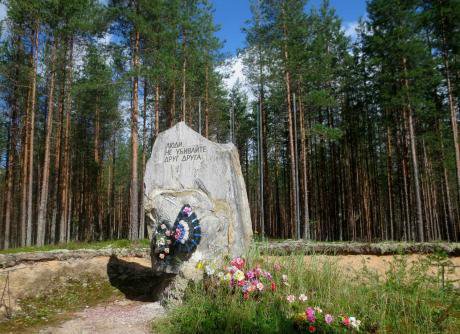
“Do not kill each other.” Photo courtesy of Natalia Shkurenok. All rights reserved.
For years, relatives of those who died here have fixed plaques to Sandarmokh’s trees, and more appear every year. “We’ve been coming for 13 years,” say sisters Elena Shebarshina and Lyudmila Denisova. They’re standing in front of a plaque fixed to a tree. “Our grandfather Pyotr Nikolaevich Barkov was shot here. He worked on the railway.”
Elena and Lyudmila tell me how their grandmother never spoke of her husband, but they, her grandchildren, try to tell their children as much as possible. When I ask if they’ve heard of Yury Dmitriyev, they both respond warmly. “Of course, it’s thanks to him that we found out that our grandfather is here! And they’ve actually put [Dmitriyev] that man on trial. You can’t make it up!”
Mikhail Alatalo, the great-grandson of Alexander Kaskelainen, a US citizen who was executed at Sandarmokh, erected a large plaque in memory of the Swedes and Finns who left for America at the beginning of the 20th century, and returned to Finland after it gained independence in 1917. Many of them came to the Soviet Union during the 1930s for work, only later to be executed. “We’ve got photographs, documents, even the ticket for the ship he arrived on,” Mikhail tells me. “Many people died like this. The secret police would take away their US passports and give them Soviet ones instead.”
Dividing lines
This year saw a delegation of historians and politicians from Germany’s Federal Foundation for the Study of the Communist Dictatorship attend events in Sandarmokh. “It’s important to bring Sandarmokh to the international arena. What happened here concerns not only Russia, but other countries, other peoples,” says Markus Meckel, East Germany’s penultimate foreign minister and nowadays a Bundestag deputy. “It’s not just Russians who lie in this soil, but Ukrainians, Estonians, Poles, Finns, Germans, Lithuanians and many, many others. The citizens of these countries also have a right to remember their countrymen.”
This year’s events also saw the attendance of Heidi Olufsen, Norway’s Consul General in St Petersburg, and Thomas Leary, the US Consul General. Embassy officers from Lithuania, Ukraine and Estonia also arrived. And every year for the past 20 without fail, a large Polish delegation has been in attendance.
“It feels like America is far away, but people who are buried here are American citizens, they came here to do something good, and they were killed,” Thomas Leary tells me. “You shouldn’t be afraid of the facts, you shouldn’t rewrite history — here, we have a common one.”
Unfortunately, the events of the past three years are once again dividing peoples and states, pushing them away from one another. For the third year in a row, the Ukrainian delegation has not attended. While public officials from Petrozavodsk and Medvezhegorsk, used to come regularly to Sandarmokh to speak about the need to preserve memory, they haven’t showed up since last year.
We don’t have the right to forget what started here 80 years ago. We should be thankful that someone like Yury Dmitriyev exists
“That angers me. I believe that kind of behaviour from the local authorities isn’t right, it’s the position of a chameleon,” says Irina Petelyaeva, a deputy of Karelia’s regional assembly from the A Just Russia political party. “We don’t have the right to forget what started here 80 years ago. We should be thankful that someone like Yury Dmitriyev exists. I can’t even find the grave of my grandfather, though it’s probably somewhere beyond the Ural mountains.”
Political prisoner
Russian society’s reaction to the arrest and trial of Yury Dmitriyev was quick and impressive. The day after he was arrested, a petition was set up to stop the investigation into the historian, which garnered thousands of signatures in a brief period of time. Russian writers, poets, journalists, academics and political scientists have come out in support of Dmitriyev, and they have been joined by their counterparts from abroad — France, Italy, United States, United Kingdom and elsewhere. At the end of July 2017, the Memorial Human Rights Association declared Dmitriyev a political prisoner and demanded the criminal investigation to be closed.
As Anatoly Razumov tells me, in February this year, Karelia hosted a meeting of the Russian Presidential Council on Human Rights — and one of the issues raised was the case against Yury Dmitriyev. Members of the council planned to meet him in pre-trial detention, but two days prior to the council’s arrival, the penitentiary service closed all the jails for quarantine.
A Ukrainian delegation arrives at Sandarmokh in 2013. Official visitors from Ukraine showed up every year to commemorate their murdered countrymen, but they haven’t shown up for three years. Photo CC-by-2.0: Visem / Wikimedia Commons. Some rights reserved.
“The investigators and prosecutor’s office were betting that if they could show everyone convincingly that, look, this is the kind of person who’s looking for those killed under Stalin, then everybody would believe them,” Razumov tells me. “But it didn’t work! So many different people came out for Yury, they understood the absurdity of the accusations. The authorities didn’t realise who they’d locked up! It’s not just Memorial who’s defending him, it’s everyone! I stood in an individual picket on 28 January, on Dmitriyev’s birthday in Petrozavodsk. Everyone who approached me either asked me to give Dmitriyev their best, asked how he was feeling in prison, or just waved their hand to say those accusations are rubbish!”
Experts on call
To confirm the accusations against Dmitriyev, the prosecutor’s office ordered an analysis of the “suspicious” photographs held on the historian’s computer. For this, they turned to the Center for Sociocultural Analysis. This “Center” has already gained some notoriety — it was this group that declared the activities of Jehovah’s Witnesses in Russia “extremist” and the Center’s analysis lay the foundations for the charges of “insulting religious believers’ feelings” against Pussy Riot. I discovered that three analysts from this Center — an art historian who researches domestic and foreign theatre, a maths teacher and a paediatrician — gave their views on the photographs. Not one of them is a psychologist, nor a sexual pathologist, nor even a qualified expert on photography.
I spoke to Lev Shcheglov, the president of Russia’s National Institute of Sexology, and who has been invited to participate in the process by Dmitriyev’s solicitor Viktor Anufriyev. Shcheglov believes the trial against Dmitriyev is part of the Soviet tradition of justice. "This is an old Soviet tradition — you don’t just punish someone, you drag them through the mud in order to scare everyone else. This is what they did to the film director Sergei Paradjanov, this is what they did to the Leningrad theatre director Zinovy Korogodsky. They just had to find something they could seize upon, and the photographs were introduced into the case, even though they bore no relation to pornography, nor to paedophilia.”
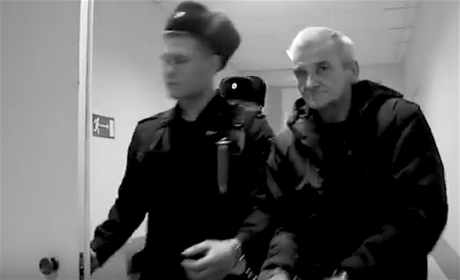
Yury Dmitriyev is brought before court in Petrozavdosk, March 2017. Image still via YouTube / Semnasem. Some rights reserved.
Irina Levinskaya, a doctor of history and a member of St Petersburg’s History Institute at the Russian Academy of Sciences, was also invited to participate in the trial. Levinskaya has been involved in filing forensic analyses for Russian courts to order (including requests from law enforcement), and has written dozens of analyses.
“Unfortunately, the analysis conducted by the Center for Sociocultural Analysis is typical of what has come to dominate this sphere,” Levinskaya tells me. “We now have a huge amount of experts who we in the business call ‘experts on call’. These are people who receive requests from the investigation and prosecutor’s office and give the answers that law enforcement want. In my opinion, what’s written in the case against Yury Dmitriyev has nothing to do with expert analysis, nor professionalism. All the rules have been broken, even if you exclude the fact that the analysis used in court makes no reference to the evidence put forward by the investigation.”
A normal system
Is the Dmitriyev case a return to the years of mass repressions and terror? Perhaps its just a bad move by the local authorities, someone’s attempt to get revenge? And how will the case end?
Anatoly Razumov, who’s done archival work around the Stalinist repressions for several years, doesn’t believe we need to look to the Great Terror. He believes the case emerged thanks to the shortcomings of the Russian judicial system. “If we had a normal judicial system, an independent one, this case would never have got to trial,” Razumov tells me. “You can start with the fact that there’s ‘anonymous’ evidence in the case. We still don’t know how these photographs ended up with the investigation! Because someone entered Dmitriyev’s apartment unlawfully? Perhaps we need to put the person who got the photographs on trial?”
Dmitriyev has held up a mirror to the realities of modern Russia. And that’s irritated and frightened some powerful people
No matter how much we might want the case against Yuri Dmitriyev to be a local misunderstanding or the result of mistakes in the Russian judicial system, many rights campaigners feel the parallels with the Stalinist terror are clear. “Twenty years ago we thought that Sandarmokh was the line between the past and the present,” Irina Flige, director of Memorial Research and Information Center in St Petersburg, said at the Day of Memory in Sandarmokh. “But now we understand that memory of the Great Terror has not become memory, it still remains relevant today. Today, our friend and colleague Yury Dmitriyev is in prison on a false and made-up charge.”
In his mission to bring light to the darker sides of Russia’s historical memory, Dmitriyev has held up a mirror to the realities of modern Russia. Clearly, that’s irritated and frightened some powerful people. Yet there is still a chance for the Petrozavodsk court to act in accordance with its conscience. The trial, held behind closed doors, has come to a close, and the sentence is expected in the next few weeks.
Translated by Liz Barnes.
Read Anna Yarovaya's interview with Yuri Dmitriyev after he was released from pre-trial detention in January 2018 here, and her coverage of the first March 2018 court hearing.
Read more
Get our weekly email
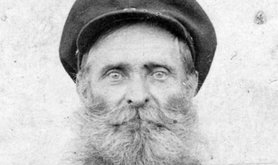
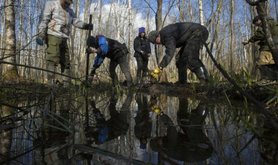
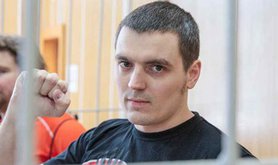
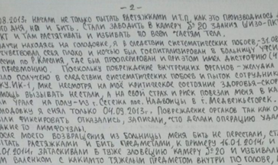
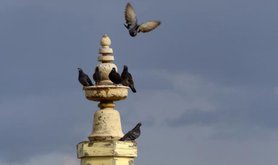

Comments
We encourage anyone to comment, please consult the oD commenting guidelines if you have any questions.